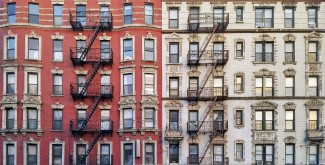With the recent Department of Energy guidance, states are racing to set up programs to tap federal incentives for home energy upgrades. States need to focus on ensuring these programs serve low-income households and especially multifamily buildings.
This summer the Department of Energy (DOE) released detailed guidance for states on setting up Home Energy Rebate programs for energy-saving and electrification upgrades, which are funded with $9 billion from the Inflation Reduction Act of 2022. The guidance addresses the many big issues in setting up these programs, setting requirements for some of them while for others—especially as they affect apartment buildings—directing states to figure out how to proceed.
Now each state is working to design its program. In March, ACEEE and our friends made several recommendations focused on serving multifamily buildings and low-income residents. Here, we assess DOE’s guidance on these issues and what it means for states writing plans.
Set aside funds for affordable housing: DOE noted, “Delivering upgrades for low-income multifamily buildings alongside critical periods of recapitalization or refinance requires a significantly longer planning, design, and construction process than energy upgrades for single-family homes.” DOE directs states to set aside roughly 40% of funds for low-income households and an additional 10% of funds for low-income multifamily units (but since rebates are larger for low-income households, that means perhaps 35% of the energy upgrades would serve those households). These percentages are minimum requirements, and DOE says states can make larger set-asides. States should look at how much need for retrofits they have in their low-income multifamily housing and consider setting aside more funds to ensure those households will be served equitably.
Ease income verification: Households that qualify for other low-income programs, like Medicaid or nutrition or energy assistance, will automatically qualify for home energy rebates. States may also allow use of a sworn statement to show income eligibility, which may be especially important for some underserved communities, but they should later verify a sample to reduce fraud. Multifamily buildings with more than half of units receiving housing assistance such as Section 8 vouchers or Low-Income Housing Tax Credits also automatically qualify. That should work well for federally supported housing, but states will need to find a way to verify eligibility for affordable apartments that are not subsidized without making the owners document the income of each renter. States could let owners use the rent levels in the units as a proxy. DOE will not provide a web tool to verify income eligibility, but it does plan to provide a template for state plans.
Protect low-income renters: For at least two years after accepting a rebate for low-income renters, landlords must continue to rent to low-income households, may not increase the rent because of the improvements except to cover costs, and may not evict residents in order to increase the rent. That’s a start, but the guidance says states should increase affordability requirements “commensurate with total rebate amount awarded.” For rental units that do not already have rent caps under a federal or other program, it’s important that the improvements benefit the low-income households, not just enable higher rents that end up displacing them.
Ensure residents get lower energy bills: Switching from gas to efficient electric heat usually, but not always, reduces energy bills. To help ensure lower energy costs, electrification rebates for heat pumps will require a “limited home assessment.” The assessment will include proper sizing of the heat pump, a visual inspection of ducts and building envelope, and if switching fuels, an estimate of utility bill impacts. States will need to set separate assessment requirements for multifamily buildings. And states also need to identify a set of conditions and/or scopes of work for which to warn the consumer of an “unacceptable risk of raising utility bills.” For the whole-home retrofit rebates, states may also help ensure bill savings by requiring envelope upgrades such as insulation and air sealing before work on equipment and appliances.
Embed efficiency upgrades in other home improvements: DOE recognizes that refinancing and renovation of subsidized multifamily properties provide a key opportunity to embed efficiency upgrades in larger projects. The only specific mechanism in the guidance for helping properties during such events is the set-asides discussed above. States should work with housing finance agencies and building owners to coordinate with the overall investment process. More broadly, DOE directs states to prepare (a year after receiving funds) a market transformation plan on how retrofits will continue after the federal funding runs out, including enabling the real estate market to value the homes at time of sale or rental. It is hard to focus on long-term impacts with so much to do just for states to get their programs up and running, but these funds are only a start on the transformation needed in our homes.
Affordable multifamily homes are “different”: Overall, DOE’s guidance includes a broad focus on low-income residents and underserved communities. States need to prepare a Community Benefits Plan along with a Consumer Protection Plan, a Utility Data Access Plan, an Education and Outreach Strategy, and a Privacy and Security Risk Assessment before program launch, as well as the Market Transformation Plan afterward. That is a lot of planning.
Multifamily buildings present unique challenges, and DOE often just says states will need to treat them differently or come up with an alternative to a process laid out for single-family homes. These differences include income qualification, utility data access, home energy assessments, modeling and measuring energy savings (and calibrating modeled savings to past energy bills), including multifamily central systems and common areas, consumer protection/quality assurance, managing multiple possible rebate claimants for the same upgrade, and braiding the rebates with other funding sources. So there also is a lot for states to figure out in making the programs work for multifamily buildings. (DOE does provide additional recommendations on affordable multifamily buildings and includes several ACEEE resources, and our R2E2 program is developing many more resources for program design.)
With unprecedented federal funding now available for energy upgrades, states have a unique opportunity to improve the quality of life for many of their most disadvantaged residents if they design their programs to prioritize and effectively serve affordable multifamily housing.


